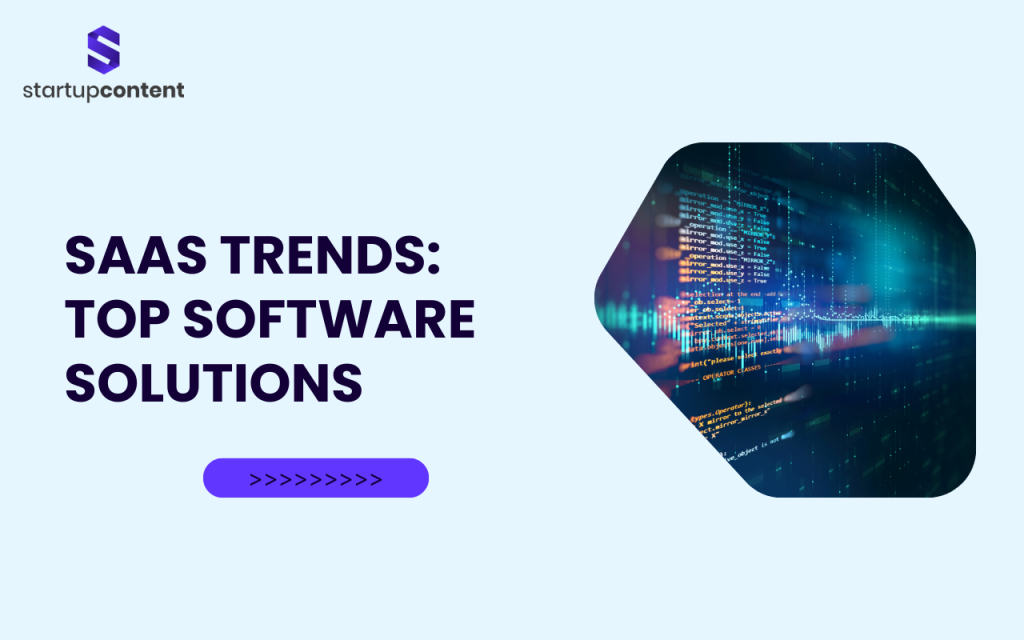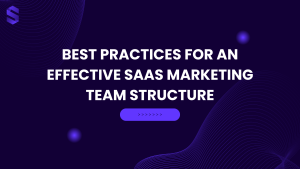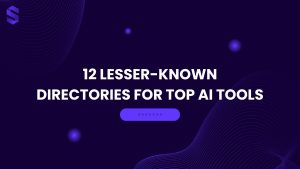SaaS is changing fast. In 2024, the industry will grow and innovate more. Cloud computing drives businesses, putting SaaS at the forefront of digital change.
Gartner predicts big growth in cloud services. Spending will reach $679 billion in 2024. This surge drives exciting SaaS trends across many sectors.
AI integration and vertical-specific offerings are diversifying the SaaS market rapidly. Artificial intelligence is making big waves in software solutions.
By 2030, AI’s market value may hit $1,811.75 billion. This tech is changing SaaS platforms. It’s improving user experience and backend operations.
SaaS is becoming essential, not just convenient. By 2025, 85% of business apps will be SaaS-powered. The future of software is clearly in the cloud.
Key Takeaways
- SaaS market projected to reach $908.21 billion by 2030
- AI integration is driving major innovations in SaaS
- Vertical SaaS solutions are on the rise
- Increased focus on cybersecurity and compliance
- Expansion of API ecosystems for seamless integrations
- Growth in remote work and collaboration tools
The Current State of SaaS Market Growth
The SaaS market is booming. By 2024’s end, it’s set to hit $317.55 billion. That’s up from $273.55 billion in 2023. Experts predict it’ll reach $1.23 trillion by 2032.
Market Size and Projections
The SaaS industry is bouncing back after a slow period. B2C software growth hit 6.3% CAGR in Q1 2024. That’s double Q4 2023’s rate.
B2B SaaS companies saw a 20% jump in new sales. This increase happened after December 2023’s low point.
Key Growth Drivers
Several factors are fueling this expansion:
- Increased focus on customer retention and value delivery
- Balancing product-led and sales-led growth strategies
- Exploration of new growth channels
- International expansion, particularly in Europe, Australia, and New Zealand
- Rising demand for AI-powered software, with 92% of business leaders considering such purchases in 2024
Industry Impact Analysis
The SaaS industry’s impact is huge. Organizations now use an average of 371 SaaS apps. That’s a 32% increase from 2021.
This growth boosts productivity and security across businesses. It’s also changing work patterns. Over 4.7 million Americans now work remotely half the time.
| Metric | Value |
|---|---|
| Expected SaaS Market Value (2024) | $317.55 billion |
| Projected CAGR (2024-2032) | 18.4% |
| Average SaaS Apps Used per Organization | 371 |
| B2B SaaS New Sales Increase (Q1 2024) | 20% |
Artificial Intelligence Revolution in SaaS
AI is changing the SaaS industry. A 2022 IBM study shows 35% of SaaS businesses use AI. Another 42% are looking into it. This shift is changing how software works and helps users.
Generative AI Integration
Generative AI leads this change. Adobe’s Sensei AI makes creative work easier. It helps with image editing and video making. Now, users of all skill levels can do these tasks better.
Predictive Analytics Capabilities
AI also improves predictive analytics in SaaS. Salesforce’s Einstein AI helps sales teams find leads and predict sales. Google Cloud’s Looker Studio uses AI to forecast sales trends. It also helps businesses run better.
AI-Powered Customer Service Solutions
AI is making customer service better in SaaS. Google Cloud’s Dialogflow creates chat interfaces using natural language processing. This tech improves customer support and user experience in SaaS apps.
AI’s impact on SaaS is big. By 2025, AI will be in almost every new software product. Global AI software revenue may reach $118.6 billion by 2025. AI in SaaS is changing how software is made and used.
AI is Reshaping SaaS—Is Your Content Keeping Up? AI-powered SaaS solutions are transforming how businesses operate. But without the right content strategy, even the best innovations can go unnoticed. Let us help you create data-driven, high-impact content that positions your SaaS brand as an industry leader. Get in touch today!
Vertical SaaS Solutions Taking Center Stage
Vertical SaaS is changing the software world. These tools are made for specific industries. They offer features that general platforms can’t provide.
The vertical SaaS market is growing fast. It may reach $157 billion by 2025. This growth shows how much businesses want targeted software.
“Vertical SaaS is 10 steps ahead in addressing industry-specific challenges,” notes a leading tech analyst.
Businesses want solutions that understand their needs. Vertical SaaS aligns with industry rules and work methods. It adds expert knowledge to every feature.
| Vertical SaaS Advantage | Impact |
|---|---|
| Tailored Features | Enhanced Efficiency |
| Regulatory Compliance | Reduced Legal Risks |
| Industry Expertise | Faster Problem Solving |
| Specialized Integrations | Improved Workflow |
Companies like Acquire Invest are leading this change. They focus on private market SaaS. By working closely with customers, they set new industry standards.
As industries get more complex, vertical SaaS becomes more appealing. It’s the future of software solutions. Businesses using these tools will have a big advantage.
Cloud Computing and Infrastructure Evolution
Cloud computing is changing tech fast. Businesses are moving to flexible, scalable solutions. This shift drives innovation and efficiency across industries.
Multi-Cloud Strategies
Companies use multi-cloud approaches to avoid vendor lock-in. They pick different cloud services for various needs. Some use AWS for computing, Google Cloud for AI, and Azure for apps.
This strategy gives flexibility and boosts performance. It allows firms to choose the best tools for each task.
Edge Computing Integration
Edge computing is growing. It processes data closer to its source. This cuts delay and speeds up response times.
Verizon’s 5G network uses edge computing for smart cities and self-driving cars. The global edge computing market will grow a lot soon.
Serverless Architecture Adoption
Serverless architecture is changing cloud computing. It lets developers focus on code, not servers. Netflix uses AWS Lambda for its serverless needs.
This approach shows how well serverless can scale. It’s becoming more popular among companies of all sizes.
| Cloud Computing Trend | Adoption Rate | Key Benefit |
|---|---|---|
| Multi-Cloud Strategy | 85% by 2024 | Vendor flexibility |
| Edge Computing | Growing rapidly | Reduced latency |
| Serverless Architecture | Increasing | Improved scalability |
Cloud computing keeps changing. Businesses must adapt to stay ahead. These trends shape IT’s future, offering new ways to grow and create.
Emerging SaaS Trends for Enterprise Solutions
Enterprise SaaS is changing fast. New trends are shaping the industry. By 2025, 85% of corporate apps will be SaaS-based.
Integration is key in enterprise SaaS. Companies want smooth connections between software solutions. This helps streamline operations and boost efficiency.
Advanced analytics is crucial for business intelligence. The SaaS market may hit $282 billion in 2024. Companies use data insights to make smart choices.
Security is vital in enterprise SaaS. Cloud security is growing fast in IT. SaaS providers are beefing up data protection and compliance measures.
“The future of enterprise SaaS lies in customization and scalability. As businesses grow, their software needs to adapt and expand with them.”
Customization is becoming more popular. Businesses can now tailor SaaS to their needs. This helps them stay competitive in changing markets.
These SaaS trends are changing how businesses work. They’re also driving innovation in the digital world.
Security and Compliance in Modern SaaS
SaaS security is a top priority for organizations. A study shows 80% of companies value SaaS security highly. 41% rank it as a critical concern.
This shift shows growing awareness of cloud-based software vulnerabilities. Companies are taking steps to protect their data.
Zero-Trust Architecture
Zero-trust architecture is gaining popularity in SaaS. It assumes no user or system is trustworthy by default. This approach requires constant verification of all users.
It’s a response to complex network environments. The rise of remote work has also driven its adoption.
Data Privacy Regulations
Compliance with data privacy laws is crucial for SaaS providers. GDPR in Europe and CCPA in the US reshape data handling.
SaaS platforms now include compliance features. These help businesses meet strict data protection requirements.
Advanced Threat Protection
SaaS providers are improving their threat protection. Multi-factor authentication (MFA) and end-to-end encryption are now standard features.
These measures protect sensitive data from unauthorized access. They also guard against cyber attacks.
| SaaS Security Measure | Adoption Rate | Impact |
|---|---|---|
| Dedicated Security Teams | 70% | Improved risk management |
| SSPM Tools | 62% | Enhanced visibility and control |
| Multi-Factor Authentication | 80% | Reduced unauthorized access |
| End-to-End Encryption | 75% | Increased data protection |
Security and compliance remain key in SaaS evolution. Organizations invest in robust security measures. They also focus on compliance frameworks.
These efforts protect data and maintain user trust. The digital landscape grows more complex, making these steps essential.
Low-Code/No-Code Platform Evolution
Software is changing fast. Low-code and no-code tools lead this shift. They make creating software easier for non-coders.
Gartner sees big growth ahead. The market may reach $26.9 billion in 2024. That’s 20% more than 2022.
These tools are popular for good reasons. They speed up development time. A custom CRM can be built in weeks.
They also reduce costs. Fewer specialized developers are needed. This saves money on development and maintenance.
Key players are shaping the field. Microsoft Power Apps, Salesforce Lightning, and Appian lead the way. Bubble and Adalo are also making an impact.
The future looks promising. AI and machine learning features are growing. Better customization is on the horizon. Security remains a top priority.
Low-code and no-code tools keep evolving. They now build complex, enterprise-grade apps. It’s an exciting time for software development!
Remote Work and Collaboration Tools
Businesses are embracing hybrid and remote work, fueling the SaaS industry boom. This shift has increased demand for remote work tools and collaboration platforms. Let’s explore the key elements shaping this landscape.
Virtual Workspace Solutions
Virtual workspace solutions are changing how teams operate. Platforms like Slack, Microsoft Teams, and Zoom enable real-time communication. These tools create online office experiences, keeping teams connected across locations.
Team Productivity Platforms
Project management tools are vital for remote teams. Asana, Trello, and Monday.com have gained popularity. These platforms help organize workflows and track progress.
They serve as the digital backbone of remote productivity. Teams can easily assign tasks and monitor project status.
Communication Integration Tools
Distributed teams need seamless communication. Google Workspace and Microsoft 365 offer integrated solutions for document sharing. These tools ensure smooth information flow across teams.
They bridge the gap created by physical distance. Team members can collaborate effectively on shared documents.
| Tool Category | Popular Platforms | Key Benefits |
|---|---|---|
| Real-time Communication | Slack, Microsoft Teams, Zoom | Instant messaging, video calls |
| Project Management | Asana, Trello, Monday.com | Task tracking, workflow organization |
| Document Collaboration | Google Workspace, Microsoft 365 | Cloud-based file sharing, co-editing |
Remote work tools are reshaping the business landscape. A survey found 95% of companies consider SaaS platforms essential for remote work. This trend will likely continue, with 92% predicting more distributed teams in SaaS companies.
Data Analytics and Business Intelligence
Data analytics and business intelligence are changing fast. SaaS analytics tools lead this shift. They offer powerful insights for business choices.
In 2024, digital tech use is rising across industries. Construction firms now use data to boost project efficiency. Real-time analytics help teams save time and reduce errors.
The Global SaaS-based Business Analytics Market is growing fast:
| Metric | Value |
|---|---|
| Estimated Growth (2024-2028) | $10.19 billion |
| Forecasted CAGR | 13.63% |
| Year-on-Year Growth (2022-2023) | 12.14% |
| North American Market Contribution | 41% |
Cloud tech use and demand for data insights drive this growth. Retail gains from cloud-based analytics. These tools give customer insights and improve operations.
AI in SaaS analytics is rising, bringing ethical concerns. Firms focus on fair and safe AI use. The AI TRiSM framework helps govern AI models well.
Some challenges exist, like connection issues and data security. Yet, the future of SaaS analytics looks bright. More companies see the value of data-driven choices.
Microservices Architecture Adoption
Microservices architecture is changing software development. It’s helping SaaS companies build and scale products better. Let’s look at the main benefits of using microservices.
Scalability Benefits
Microservices offer great scalability for SaaS platforms. They break apps into smaller, independent services. Companies can scale specific parts as needed.
This approach allows for better resource use and cost management. It’s more efficient than traditional methods.
| Metric | Before Microservices | After Microservices |
|---|---|---|
| Feature Delivery Time | Over 1 year | Few months to weeks |
| Physical Servers | 100% | 50% reduction |
| Deployment Time | 40 hours | 30 minutes |
Integration Capabilities
Microservices are great at integrating with other services and APIs. This helps SaaS companies adapt quickly to market needs. They can add new features without disrupting the whole system.
Development Flexibility
Microservices give development teams more freedom. They can work on different parts at the same time. Updates happen more often, and new tech is easier to try.
This flexibility is key in the fast-moving SaaS world. It helps companies stay ahead of the competition.
The global microservices market is growing fast. It’s expected to reach $11.8 billion by 2032. This shows that more industries are using microservices, especially in banking and big companies.
Mobile-First SaaS Solutions
The mobile SaaS market is set to reach $35 billion by 2028. This growth shows the high demand for on-the-go services. Users interact with about 9 apps daily, pushing SaaS providers to focus on mobile.
Mobile-first SaaS solutions focus on responsive designs and native apps. This approach offers many perks:
- Enhanced user experience on smaller screens
- Improved productivity with anytime, anywhere access
- Higher conversion rates (3x) compared to mobile sites
- Increased product views (4.2x) per session
Successful mobile SaaS needs to put user needs first. Duolingo’s A/B testing shows the power of this approach. HotJar’s mistake in data checking serves as a warning.
Key factors for mobile SaaS success include:
- Optimizing for one-handed use
- Implementing user-friendly touch interfaces (48×48 dpi targets)
- Streamlining sign-up processes with social media options
- Avoiding disruptive elements like pop-ups
Mobile SaaS has great benefits, but it also faces challenges. Developers must focus on UX, connectivity, and security. This approach helps create competitive solutions.
By going mobile-first, SaaS providers can tap into the smartphone market. They can offer flexible, cost-effective solutions for organizations.
API Integration and Ecosystem Expansion
API integration is changing the SaaS ecosystem. Businesses want apps to connect smoothly. This shift is reshaping how companies use software tools.
Third-Party Integrations
Third-party integrations are vital in SaaS. Slack and Shopify grew by opening platforms to developers. Users can now customize workflows without leaving their main app.
API Marketplace Growth
API marketplaces are growing fast. They offer pre-built integrations for easy tool connection. Zapier leads by focusing on API integrations across hundreds of apps.
Custom Integration Solutions
Custom integration solutions are becoming popular. Businesses tailor their SaaS stack to fit specific needs. This trend drives innovation and creates new income for SaaS providers.
| API Integration Benefits | Impact on SaaS Ecosystem |
|---|---|
| Expanded Functionality | Enhanced product capabilities |
| User Stickiness | Increased customer retention |
| New Revenue Streams | Additional income opportunities |
| Market Expansion | Entry into new user segments |
API integration in SaaS looks bright. New tech like AI and IoT will bring more cool features. SaaS products might soon work with smart homes and self-driving cars.
These changes will open up new possibilities in the digital world. The SaaS ecosystem will keep growing and improving.
Subscription Model Innovation
SaaS subscription models are changing. Pricing innovation leads the way. The global subscription economy is growing fast. It may reach $1.5 trillion by 2025.
In 2021, US consumers spent $273 monthly on subscriptions. This was up from $237 in 2018. SaaS companies are rethinking their pricing strategies.
Usage-based pricing, freemium models, and tiered plans are popular. These align costs with value delivered. The Freemium Model offers free basic service with paid upgrades.
The Usage Model charges based on consumption. It provides transparency and flexibility. Tiered subscriptions cater to diverse customer needs.
Some innovative SaaS subscription models include:
- Perks Model: Adding value through insurance, discounts, or freebies
- Hybrid Model: Combining subscription and usage-based elements
- Value-Based Pricing: Aligning costs with customer-perceived value
These pricing innovations aim to meet diverse business needs. They also maximize customer satisfaction and retention. As the market changes, expect more creative pricing strategies.
Personalization and Customer Experience
Personalization is changing the SaaS world. Companies use AI tools to boost customer satisfaction and retention. Let’s explore how SaaS personalization is reshaping customer experience.
AI-Driven Personalization
AI is transforming how SaaS companies interact with users. Grammarly uses AI to offer tailored writing suggestions based on preferences.
ClickUp lets users customize their dashboard. They can hide or show menu items as needed. This enhances user engagement and productivity.
Customer Journey Mapping
SaaS providers are improving touchpoints throughout the customer lifecycle. Userpilot creates custom in-app checklists for new and advanced users.
Loom offers personalized upsells at key moments. This improves customer satisfaction and boosts revenue.
User Behavior Analytics
Analytics are vital in enhancing SaaS personalization. Kommunicate triggers interactive walkthroughs for users trying new features.
This approach helps companies improve product features and user engagement. 60% of CX executives see AI as a game-changer.
The future of SaaS customer experience looks bright and highly personalized.
SaaS is evolving—your content should too. From AI integration to personalization trends, the industry is moving fast. Partner with us to craft compelling, optimized content that attracts, engages, and converts. Ready to level up your SaaS content strategy? Let’s talk!
FAQ
What is the projected size of the SaaS market by 2030?
The SaaS market is set to hit 8.21 billion by 2030. It’s growing at a CAGR of 18.7%. This shows how popular cloud-based solutions are becoming.
How is AI transforming the SaaS industry?
AI is changing SaaS through automation, personalization, and better efficiency. It’s being used in generative AI, predictive analytics, and customer service. The AI market in SaaS could reach
FAQ
What is the projected size of the SaaS market by 2030?
The SaaS market is set to hit $908.21 billion by 2030. It’s growing at a CAGR of 18.7%. This shows how popular cloud-based solutions are becoming.
How is AI transforming the SaaS industry?
AI is changing SaaS through automation, personalization, and better efficiency. It’s being used in generative AI, predictive analytics, and customer service. The AI market in SaaS could reach $1,811.75 billion by 2030.
What are vertical SaaS solutions?
Vertical SaaS solutions are made for specific industries like healthcare and finance. They offer special features and follow industry rules. These solutions fix unique problems in each field.
How is cloud computing evolving in the SaaS landscape?
Cloud computing in SaaS now uses multi-cloud strategies and edge computing. It’s also adopting serverless architecture. These changes make SaaS work better and cost less.
What security measures are becoming standard in modern SaaS offerings?
Modern SaaS security now includes zero-trust architecture and advanced threat protection. Multi-factor authentication and encryption are also common. SaaS platforms are building in features to follow data privacy laws.
How are low-code and no-code platforms impacting SaaS development?
Low-code and no-code platforms make software development easier for everyone. They help create apps faster and save money. This trend speeds up new app launches and sparks creativity.
What trends are shaping remote work and collaboration tools in SaaS?
Virtual workspaces are trying to copy office experiences online. Team productivity platforms are making project management better. Communication tools are helping teams work together smoothly from anywhere.
How is data analytics being integrated into SaaS offerings?
SaaS now includes advanced analytics tools and real-time analytics. It also offers predictive modeling and data visualization. These tools help companies make smart choices based on data.
What is microservices architecture, and why is it gaining popularity in SaaS?
Microservices architecture breaks apps into smaller, independent parts. It’s popular in SaaS because it’s easy to scale. It also makes integration and updates simpler.
How are SaaS subscription models evolving?
SaaS subscriptions now offer more choices. These include usage-based pricing and tiered subscriptions. Some mix subscriptions with usage-based pricing. These changes aim to give customers better value.
What role does personalization play in modern SaaS solutions?
Personalization is becoming very important in SaaS. It uses AI to create custom user experiences. It also maps customer journeys and studies user behavior. This helps keep customers happy in a competitive market.
,811.75 billion by 2030.
What are vertical SaaS solutions?
Vertical SaaS solutions are made for specific industries like healthcare and finance. They offer special features and follow industry rules. These solutions fix unique problems in each field.
How is cloud computing evolving in the SaaS landscape?
Cloud computing in SaaS now uses multi-cloud strategies and edge computing. It’s also adopting serverless architecture. These changes make SaaS work better and cost less.
What security measures are becoming standard in modern SaaS offerings?
Modern SaaS security now includes zero-trust architecture and advanced threat protection. Multi-factor authentication and encryption are also common. SaaS platforms are building in features to follow data privacy laws.
How are low-code and no-code platforms impacting SaaS development?
Low-code and no-code platforms make software development easier for everyone. They help create apps faster and save money. This trend speeds up new app launches and sparks creativity.
What trends are shaping remote work and collaboration tools in SaaS?
Virtual workspaces are trying to copy office experiences online. Team productivity platforms are making project management better. Communication tools are helping teams work together smoothly from anywhere.
How is data analytics being integrated into SaaS offerings?
SaaS now includes advanced analytics tools and real-time analytics. It also offers predictive modeling and data visualization. These tools help companies make smart choices based on data.
What is microservices architecture, and why is it gaining popularity in SaaS?
Microservices architecture breaks apps into smaller, independent parts. It’s popular in SaaS because it’s easy to scale. It also makes integration and updates simpler.
How are SaaS subscription models evolving?
SaaS subscriptions now offer more choices. These include usage-based pricing and tiered subscriptions. Some mix subscriptions with usage-based pricing. These changes aim to give customers better value.
What role does personalization play in modern SaaS solutions?
Personalization is becoming very important in SaaS. It uses AI to create custom user experiences. It also maps customer journeys and studies user behavior. This helps keep customers happy in a competitive market.







